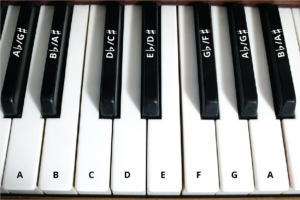- Explain the fundamentals of frequency and pitch in the context of sound and music
- Assess musical elements including notes, half-steps, whole steps, and octaves
- Determine octave frequencies and their relevance in music
The Mathematics of Music
Prepare to embark on an auditory exploration where mathematics and music harmonize to reveal the intricacies of sound. In this ‘Apply It’ activity, you will delve into the foundational elements of music theory—frequency, pitch, and the scales that orchestrate our melodies. By dissecting the relationship between frequency and pitch, evaluating musical notes in scales, and calculating the frequencies of octaves, you will uncover the mathematical underpinnings that compose the world of music.
Understanding Frequency and Pitch
A music teacher is explaining the concept of pitch to her students using a keyboard as a reference.
As we transition from the foundational concepts of frequency and pitch, which dictate the very essence of the sounds we perceive, we move towards the structured world of musical scales. Next, we will bridge the auditory with the symbolic, deciphering the steps between notes that form the major scale—a building block for melodies and harmonies that have echoed through time.
Musical Scales and Steps
The students in the class are learning about musical scales and the relationships between notes on a keyboard. They are using a keyboard diagram to explore how notes are arranged and to understand the concepts of half-steps, whole steps, and octaves.
